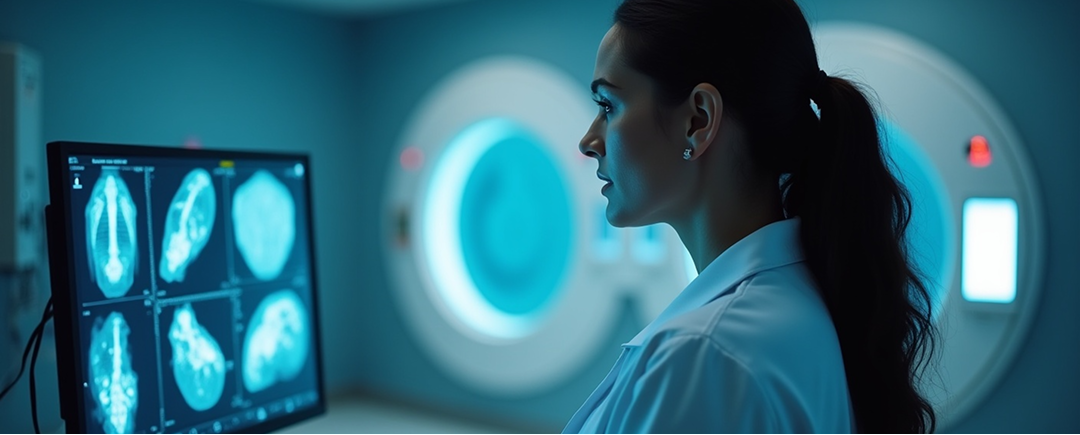
Nuclear Medicine
Precision Molecular Imaging & Targeted Radionuclide Therapy.
PET-CT, SPECT-CT, and theranostics that visualize and treat disease at the cellular level.
The Nuclear Medicine Service offers a comprehensive portfolio of molecular imaging and therapy. Diagnostic modalities include PET-CT with ⁶⁸Ga-DOTATATE, ¹⁸F-FDG, ¹⁸F-PSMA, ¹⁸F-FET; SPECT-CT for bone, cardiac perfusion, and endocrine studies; and hybrid imaging with CZT cardiac cameras. On-site radiopharmacy enables same-day tracer production and targeted therapy—¹⁷⁷Lu-DOTATATE for neuroendocrine tumors, ¹³¹I-MIBG for neuroblastoma and pheochromocytoma, ¹³¹I for thyroid cancer, and ¹⁷⁷Lu-PSMA for metastatic prostate cancer. Multidisciplinary theranostic boards coordinate personalized treatment plans with oncology, endocrinology, and surgery.
On-site ISO-Class 5 radiopharmacy producing ⁹⁹ᵐTc, ⁶⁸Ga, ¹⁷⁷Lu radiopharmaceuticals daily
Common Conditions & Subspecialty Clinics.
- High-dose ¹³¹I ablation for thyroid cancer
- ¹³¹I-MIBG therapy for neuroblastoma
- ¹⁷⁷Lu-DOTATATE therapy for NETs
- ¹⁷⁷Lu-PSMA therapy for metastatic prostate cancer
- Three-phase bone scan for orthopedic conditions
- WBC-labeled SPECT-CT for osteomyelitis and fever of unknown origin
- ⁶⁸Ga-Citrate PET for prosthetic joint or implant-associated infections
- DaTscan™ (¹²³I-ioflupane) for Parkinsonian syndromes
- Cerebral perfusion SPECT for epilepsy localization
- Amyloid PET imaging in Alzheimer’s and other dementias
- ¹⁸F-FDG PET-CT for cancer staging and response assessment
- ⁶⁸Ga-DOTATATE PET for neuroendocrine tumors (NETs)
- ¹⁸F-PSMA PET for prostate cancer imaging
- Theranostic therapies: ¹⁷⁷Lu-DOTATATE, ¹⁷⁷Lu-PSMA
- Thyroid uptake and scan for nodules and hyperthyroidism
- Parathyroid localization with SPECT-CT
- Radioactive iodine (¹³¹I) ablation therapy
- Graves disease radioiodine treatment
- Myocardial perfusion imaging (SPECT or PET with N13-ammonia)
- MUGA scan for ejection fraction assessment
- Cardiac viability assessment using FDG-PET
- Bone scan for skeletal metastases
- Renal scans (DMSA for cortical defects, MAG3 for drainage and perfusion)
- Gastric emptying study for gastroparesis
- Hepatobiliary HIDA scan for cholecystitis or bile leak
Procedures & Treatments.
Voxelized Dosimetry using SPECT-CT post-therapy imaging
Renal MAG3 & DMSA Scans for obstruction and cortical defect
Bone SPECT-CT with CZT camera for occult fractures and metastases
Cardiac PET N13-Ammonia with absolute MBF quantification
¹⁸F-PSMA & ⁶⁸Ga-PSMA PET-CT for high-risk and recurrent prostate cancer
⁶⁸Ga-DOTATATE / DOTATOC PET-CT for neuroendocrine-tumor detection and PRRT eligibility
¹⁸F-FDG PET-CT for oncology staging, treatment response, and fever of unknown origin
SIRTEX Surefire Dosimetry for personalized Y-90 dosing
Y-90 Radioembolization (TheraSphere™ / SIR-Spheres®) in collaboration with Interventional Radiology
Sm-153 EDTMP & ¹⁸⁹Re-HEDP for painful bone metastases
¹⁷⁷Lu-PSMA-617 Therapy for metastatic castration-resistant prostate cancer (mCRPC)
¹³¹I-MIBG Therapy for neuroblastoma and pheochromocytoma
¹⁷⁷Lu-DOTATATE Peptide Receptor Radionuclide Therapy (PRRT) for metastatic/unresectable NETs
¹³¹I Radioiodine for Graves disease and differentiated thyroid cancer ablation
Care Pathway & Coordination.
Referral & Indication Review
Nuclear physician verifies appropriateness; pre-authorization obtained.
Tracer Production & Scheduling
On-site radiopharmacy prepares radiotracer; patient scheduled within 1–3 days (imaging) or 1 week (therapy).
Imaging / Therapy Day
Patient receives tracer or therapeutic dose; imaging at specified time-points.
Image Reconstruction & Analysis
AI motion correction and SUV quantification; physicist calculates dosimetry for therapy.
Report & Multidisciplinary Discussion
Results delivered within 24 hours; tumor board review for complex cases.
Follow-Up
Post-therapy labs/imaging at 4–6 weeks; repeat cycles as protocol dictates; surveillance imaging schedule.
Technology & Facilities.
Digital TOF PET-CT (Siemens Biograph Vision) – 3.5 mm resolution, ultra-high sensitivity CZT Cardiac SPECT Camera
10-minute stress scan with low radiation
SPECT-CT (Symbia Intevo Bold)
High-resolution 16-slice CT for attenuation correction
ISO-Class 5 Radiopharmacy
Automated dose fractionator, ⁶⁸Ge/⁶⁸Ga generators, ¹⁷⁷Lu hot-cells
Theranostic Therapy Suite – Lead-lined rooms with in-room gamma probes and patient entertainment
AI Dosimetry Platform
Voxel-based dose distribution for personalized therapy



